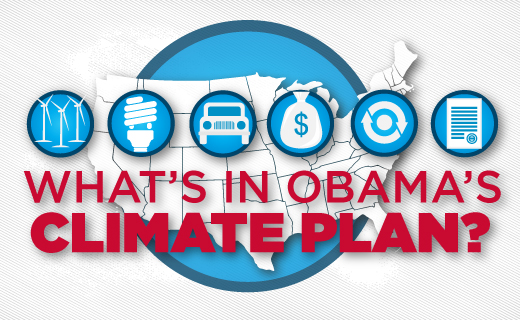
Earlier this month, President Obama introduced his national budget for next year which involved a chunk of it aiming towards addressing climate issues. Obama’s $3.9 trillion document assigns an estimated $1 trillion for unrestricted spending across both defense and non-defense, with the remaining going to required programs like Medicare and Social Security. Included in that $1 trillion, Obama has carved out diverse programs to advance towards his climate action plan he declared last year. Granted by briefing documents released by the White House, the President stated that he would spend $1 billion to gain a sharpened understanding of the calculated effects of climate change, to stimulate local action to diminish future hazards, and to reserve technology and infrastructure that will be more flexible with climate change.


The focal point of Obama’s plan is continued funding for regulations by the Environmental Protection Agency (EPA) to cut carbon dioxide emissions from the nation’s power plants. The agency has already revealed the rules for new plants, and should release its rules for existing plants in June of this year. Gina McCarthy, the administrator of the EPA, stated last year that the EPA will present suggestions for current coal plants, accountable for around 40% of greenhouse gas emissions by June of this year. She also announced that the federal government was acting to cut down methane from natural gas drilling and additional manufacturers, which are a rapid growing cause of emissions. “It is by far the largest industry sector in terms of its generation of greenhouse gases,” she said. McCarthy admitted that the EPA could not carry out all of the cutbacks in greenhouse gas emissions essential to refrain from the most catastrophic consequences of climate change on its own.
 In the budget, there is a great deal on climate and green energy issues. One major component is clean energy tax credits. These involve a enduring continuation of the production tax credit for wind (a cost of $19.2 billion over ten years) which concluded at the end of 2013. Along with that, there is $401 million over that time period for different fuel trucks tax credits, and $1.7 billion for cellulosic biofuel. Obama also wants to cut fossil fuel tax breaks with the budget cutting about $4 billion in tax breaks that are now accessible to the oil and natural gas industries, and another $3.9 billion in tax preferences for coal. Last month, the President announced a climate resiliency endowment and said he would ask Congress for $1 billion to fund new technology and infrastructure to get ready for climate change, help for communities, and new research– which the budget makes good promise on. Another point is that Obama wants $2 billion to completely fund a new fleet of weather satellites for the National Oceanic and Atmospheric Administration. Furthermore, he even pushes for clean energy technology and claims that The National Science Foundation would receive $362 million below the budget to examine leading forms of green energy.
In the budget, there is a great deal on climate and green energy issues. One major component is clean energy tax credits. These involve a enduring continuation of the production tax credit for wind (a cost of $19.2 billion over ten years) which concluded at the end of 2013. Along with that, there is $401 million over that time period for different fuel trucks tax credits, and $1.7 billion for cellulosic biofuel. Obama also wants to cut fossil fuel tax breaks with the budget cutting about $4 billion in tax breaks that are now accessible to the oil and natural gas industries, and another $3.9 billion in tax preferences for coal. Last month, the President announced a climate resiliency endowment and said he would ask Congress for $1 billion to fund new technology and infrastructure to get ready for climate change, help for communities, and new research– which the budget makes good promise on. Another point is that Obama wants $2 billion to completely fund a new fleet of weather satellites for the National Oceanic and Atmospheric Administration. Furthermore, he even pushes for clean energy technology and claims that The National Science Foundation would receive $362 million below the budget to examine leading forms of green energy.


In 2015, overall the budget will have increased funding for the Energy Department to $27.9 billion. This would result in an increase of 2.6 percent over this year. That contains $355 million to strengthen the robustness of the electrical grid and fuel transportation infrastructure. It’s deemed pretty unlikely that Congress will pass Obama’s budget. The Union of Concerned Scientists see eye to eye with Obama’s preferences. Angela Anderson, the directors of the group’s Climate Energy Program stated “the president is confronting members of Congress with a reality they need to face: climate change is already hurting us economically. “Resilience funding is essential to confront the consequences of climate change already being felt. Beyond that, Congress needs to get serious about reducing the risks of the changing climate. Unless and until we start cutting emissions that cause global warming, the problems communities are facing, and their price tags, will continue to grow”. In his budget, President Obama highlighted some of these favorable steps, particularly renewing the production tax credit for wind energy.
http://www.washingtonpost.com/politics/obama-to-propose-1-billion-to-prepare-for-climate-change/2014/02/14/d18d3712-95a5-11e3-afce-3e7c922ef31e_story.html
http://thinkprogress.org/climate/2014/03/05/3366331/obama-2015-budget-climate
http://www.theguardian.com/environment/2013/sep/18/epa-obama-climate-change-plan-congress







